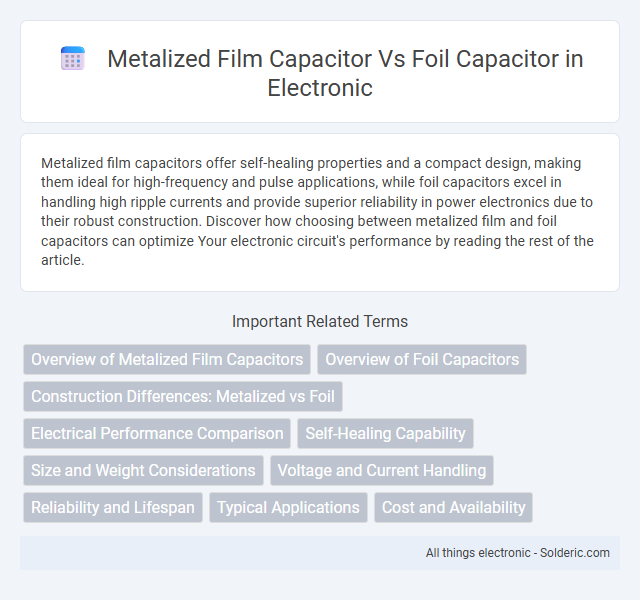Metalized film capacitors offer self-healing properties and a compact design, making them ideal for high-frequency and pulse applications, while foil capacitors excel in handling high ripple currents and provide superior reliability in power electronics due to their robust construction. Discover how choosing between metalized film and foil capacitors can optimize Your electronic circuit's performance by reading the rest of the article.
Comparison Table
| Feature | Metalized Film Capacitor | Foil Capacitor |
|---|---|---|
| Construction | Plastic film with a thin metalized coating | Plastic film sandwiched between metal foil electrodes |
| Self-Healing | Yes, self-healing capability | No, requires external protection |
| Size | Smaller, compact design | Larger physical size for same capacitance |
| Capacitance Range | Low to medium capacitance (pF to uF) | Medium to high capacitance (nF to mF) |
| Voltage Rating | Up to several kV | Typically higher voltage tolerance |
| Reliability | High due to self-healing | Good, but less tolerant to faults |
| Cost | Generally lower cost | Usually higher cost |
| Applications | General-purpose, filtering, timing | High-power, pulse, snubber circuits |
Overview of Metalized Film Capacitors
Metalized film capacitors use a thin metal layer deposited on a plastic film as electrodes, providing self-healing properties that improve reliability and longevity compared to foil capacitors, which employ separate metal foil electrodes. These capacitors excel in high-frequency applications due to their lower equivalent series resistance (ESR) and compact design, making them ideal for power electronics and filtering circuits. You can choose metalized film capacitors for enhanced performance in environments requiring stable capacitance and durability under electrical stress.
Overview of Foil Capacitors
Foil capacitors use stacked metal foil electrodes separated by a dielectric material, providing low equivalent series resistance (ESR) and high current handling capabilities. Their robust construction ensures superior pulse-handling and reliability in high-voltage and high-frequency applications compared to metallized film capacitors. Foil capacitors are preferred in demanding power electronics and industrial environments due to their durability and stable performance under stress.
Construction Differences: Metalized vs Foil
Metalized film capacitors feature a thin metalized layer deposited directly onto the plastic film, creating a self-healing effect that improves reliability and reduces size. Foil capacitors use separate metal foil electrodes sandwiched between dielectric films, resulting in higher surge current handling but larger physical dimensions. Your choice depends on the application's need for compactness and self-healing properties versus surge current capacity and longevity.
Electrical Performance Comparison
Metalized film capacitors exhibit lower equivalent series resistance (ESR) and higher self-healing capabilities compared to foil capacitors, enhancing their reliability under voltage stress. Foil capacitors generally provide superior high-frequency performance and better surge current handling due to their robust electrode structure. Your choice depends on whether long-term stability and compact size or high pulse current tolerance and lower energy losses align better with your application requirements.
Self-Healing Capability
Metallized film capacitors exhibit superior self-healing capability compared to foil capacitors due to their thin metal layer deposited directly on the dielectric film, which allows localized dielectric breakdowns to vaporize the metal around the fault site without compromising the overall capacitor function. In contrast, foil capacitors, composed of solid metal foils, lack this ability to isolate and repair damage, often leading to permanent failure after dielectric breakdown. This self-healing property makes metallized film capacitors highly reliable for applications requiring long-term stability and fault tolerance.
Size and Weight Considerations
Metalized film capacitors typically offer a more compact and lightweight design compared to foil capacitors due to their thinner dielectric layers and self-healing properties. Foil capacitors, while often larger and heavier, provide higher pulse current capabilities and improved reliability in high-stress applications. Choosing between the two depends on the specific size and weight constraints of the electronic device or system design requirements.
Voltage and Current Handling
Metalized film capacitors typically handle higher voltages with self-healing properties that allow them to recover from dielectric breakdowns, making them suitable for applications up to several kilovolts. Foil capacitors usually offer superior current handling capabilities due to their low equivalent series resistance (ESR) and inductance, which result in better performance under high ripple current conditions. Voltage ratings for foil capacitors are generally lower than metalized film capacitors, but their robust construction supports demanding high-current environments in power electronics.
Reliability and Lifespan
Metalized film capacitors offer higher self-healing capabilities, which significantly enhance their reliability and extend their lifespan compared to foil capacitors. Their thin metalized layer allows for localized fault repair, preventing complete failure and maintaining performance over time. When selecting a capacitor for long-term applications, you can expect metalized film capacitors to provide superior durability and consistent operation under varied environmental conditions.
Typical Applications
Metalized film capacitors are commonly used in high-frequency applications such as power supplies, motor run circuits, and pulse discharge circuits due to their self-healing properties and compact size. Foil capacitors, with their higher current handling capacity and lower ESR, are preferred in audio equipment, power factor correction, and EMI/RFI filtering where stable capacitance and durability under high ripple currents are essential. Both types serve critical roles in electronics, with metalized film capacitors favored for space-saving designs and foil capacitors for high-reliability industrial applications.
Cost and Availability
Metalized film capacitors generally offer lower cost and higher availability due to their automated manufacturing process using thin metalized films, which reduces material usage and production time. Foil capacitors, composed of larger metal foil layers and thicker dielectric, tend to be more expensive and less readily available because of their labor-intensive assembly and higher material costs. Market demand favors metalized film capacitors in applications requiring economical bulk production, making them more accessible and affordable compared to foil capacitors.
metalized film capacitor vs foil capacitor Infographic

 solderic.com
solderic.com